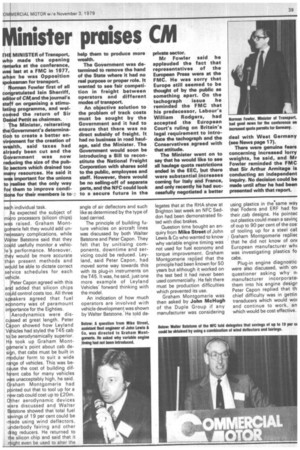Diesels to reign supreme
Page 40

Page 41

If you've noticed an error in this article please click here to report it so we can fix it.
THERE WILL BE no dramatic changes in heavy commercial-vehicle design in the 1980s — that's the message from this year's Fleet Management Conference.
Three separate speakers on the subject of technical development in the heavy goods vehicle range all agreed that the diesel engine will reign supreme at least for the next decade. Graham Montgomerie, Commercial Motor's, engineering editor, said that alternative power units such as the gas turbine and Stirling engine would not be viable for many years. Rather, he'felt, the diesel engine would be developed with
the likes of turbocharging and charge cooling becoming increasingly prevalent. Engines were being designed from the outset to be turbocharged, he said, and in future they would be de-turboed only if operators insisted.
Walter Batstone, of the National Freight Corporation, agreed that these developments were inevitable and that high torque rise engines were the thing of the future. This development gave power units a great degree of usable torque and a better lug-down ability, necessitating less frequent gear changing. Graham Montgomerie asserted that improvements over the last 20 years had already cut the diesel engine fuel consumption by 20 per cent and that in future saving fuel by cutting parasitic losses would be of paramount importance for designers.
Speaking for the operating side of the business, Walter Batstone went on to say that these modern engine designs needed to be matched to correct
transmissions and drive lines. He pointed out that a typical six-speed gearbox installation had 700rpm steps between ratios while a nine speed cut this to 400rpm. While sharing Graham Montgomerie's view that automatic transmission would be more widely used on smaller goods vehicles, he felt that such developments as the Ratcliff Hobbs variable kinetic flywheel device would overtake both manual and automatic gearboxes. Graham Montgomerie had already said that many operators were looking at the ZF transmatic type of .gearbox which had proved itself to be more economical than was at first expected. Indeed one manufacturer, Seddon Atkinson, had already offered the transmatic as an on-line option. Both Graham Montgomerie and Walter Batstone agreed that single-reduction rear axles, rather than double reduction, would be the trend for the next few years.
This view was not shared however, by Peter Capon of Leyland Vehicles who felt that demand would be the deciding factor. Certainly he believed in outlining Leyland's new vehicle plan that operators would be the ones to choose and that the manufacturers would supply those components required for each individual task.
As expected the subject of miCro processors (silicon chips) was raised. Graham Montgo erie felt they would add un= ne essary complications, while W lter Batstone said that they co Id usefully monitor a vehicle' performance. Moreover, thy would be more accurate than present methods and wOuld be able to dictate correct service schedules for each vehicle.
:Peted added that silicon chips r Capon agreed with this a1,
could control costs too. All three speakers agreed that fuel edonomy was of paramount importance for the Eighties.
Aerodynamics were discussed at great length. Peter Capon showed how Leyland V hides had styled the T45 cab to be aerodynamically superior. H took up Graham Montg merie's point about cab desi n, that cabs must be built in modular form to suit a wide range of vehicles. This was because the cost of building different cabs for many vehicles \Nos unacceptably high, he said. Graham Montgomerie had pointed out that to tool up for a naw cab could cost up to £20m. Other aerodynamic devices were discussed and Walter Biatstone showed that total fuel savings of 19 per cent could be 'Made using wind deflectors, nderbody fairing and other drag reducers. He returned to the silicon chip and said that it night even be used to alter the angle of air deflectors and such like as determined by the type of load carried.
The principle of building future vehicles on aircraft lines was discussed by both Walter Batstone and Peter Capon. They felt that by unitising components, downtime and servicing could be reduced. Leyland, said Peter Capon, had moved some way towards this with its plug-in instruments on the T45. It was, he said, just one more example of Leyland Vehicles forward thinking with the model.
An indication of how much operators are involved with vehicle development was shown by Walter Batstone. He told de legates that at the RHA show at Brighton last week an NFC Seddon had been demonstrated fitted with disc brakes.
Question time bought an enquiry from Mike Street of John Lewis & Co who wanted to know why variable engine timing was not used for fuel economy and torque improvement. Graham Montgomerie replied that the principle had been known for 50 years but although it worked on the test bed it had never been used commercially. He felt there must be production difficulties which prevented its use.
Graham Montgomerie was then asked by John McHugh of the Duple Group if any manufacturer was considering
using plastics in the.same way that Fodens and ERE had for their cab designs. He pointed out plastics could mean a savinc of oup to 90 per cent of the cos' of tooling up for a steel cat Graham Montgomerie repliec that he did not know of on( European manufacturer wh( was investigating plastics fo cabs.
Plug-in engine diagnostic were also discussed, with on questioner asking why ni .manufacturer incorporatei them into his engine design Peter Capon replied that th chief difficulty was in gettin transducers which would wot and continue to work, an which would be cost effective.




























































































































